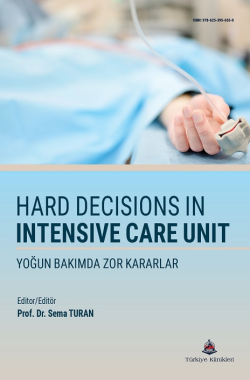FLUID-ELECTROLYTE BALANCE
Dilek Kuzukıran Kocataş
Ankara City Hospital, Department of Intensive Care, Ankara, Türkiye
Kuzukıran Kocataş D. Fluid-Electrolyte Balance. In: Turan S, editor. Hard Decisions in Intensive Care Unit. 1st ed. Ankara: Türkiye Klinikleri; 2025. p.265-277.
ABSTRACT
The management of fluid and electrolyte balance necessitates a profound understanding of the distribution of body fluids-one of the fundamental dynamics of life-and the metabolism of water and electrolytes. The human body is built upon a balanced system of fluids, encompassing compartments such as cells and interstitial spaces. These fluids not only provide an optimal environment for cellular function but also facilitate the transport of oxygen and nutrients. The maintenance of vital functions is inherently dependent on the homeostasis of these fluids in terms of volume, concentration, and composition.
Sodium imbalances are often attributed to excessive retention or loss of water, while excessive sodium intake or loss is rarely the primary cause. In the management of electrolyte disturbances such as hyperkalemia, addressing life-threatening symptoms takes precedence. Fluid therapy for critically ill patients is guided by evidence derived from randomized controlled trials. This therapy assumes particular significance in the context of surgical procedures-preoperative, intraoperative, and postoperative periods-as well as in response to stressors such as trauma and infection.
In conclusion, a thorough understanding of fundamental concepts, including the physiology of body fluids, alterations in electrolyte composition, and resuscitative fluid options, plays a pivotal role in the management of fluid and electrolyte balance. Such knowledge establishes a robust foundation for comprehending and managing common fluid and electrolyte disturbances, thereby optimizing patient care.
Keywords: Electrolytes; Hyopnatraemia; Hyperkalaemia; Fluid therapy; Water balance
Kaynak Göster
Referanslar
- Edelman IS, Leibman J. Anatomy of body water and electrolytes. Am J Med. 1959;27:256-77. [Crossref] [PubMed]
- Gamble JL. Chemical anatomy, physiology, and pathology of extracellular fluid. 6th ed. Cambridge (MA): Harvard University Press; 1954. [Link]
- Moore FD, Olesen KH, McMurray JD. Body Composition in Health and Disease. Philadelphia: WB Saunders; 1963. [Link]
- Phillips PJ. Water metabolism. Anaesth Intensive Care. 1977;5(4):295-304. [Crossref] [PubMed]
- Humes HD. Disorders of water metabolism. In: Kokko JP, Tannen RL, editors. Fluids and electrolytes. Philadelphia: WB Saunders; 1986. p. 128-136.
- Bourque CW, Oliet SHR. Osmoreceptors in the central nervous system. Annu Rev Physiol. 1997;59:601-619. [Crossref] [PubMed]
- Stauss HM. Baroreceptor reflex function. Am J Physiol Regul Integr Comp Physiol. 2002;283(2):R284-6. [Crossref]
- Miller M. Syndromes of excess antidiuretic hormone release. Crit Care Clin. 2001;17(1):11-23. [Crossref]
- Adrogué HJ, Madias NE. Hypernatremia. N Engl J Med. 2000;342(20):1493-9. [Crossref] [PubMed]
- Worthley LI. Hyperosmolar coma treated with intravenous sterile water: a study of three cases. Arch Intern Med. 1986;146:945-7. [Crossref] [PubMed]
- Phelan DM, Worthley LI. Hypokalaemic coma. Intensive Care Med. 1985;11(5):257-8. [Crossref]
- Kapoor M, Chan GZ. Fluid and electrolyte abnormalities. Crit Care Clin. 2001;17(3):503-29. [Crossref] [PubMed]
- Adrogué HJ, Lederer ED, Suki WN, Eknoyan G. Determinants of plasma potassium levels in diabetic ketoacidosis. Medicine (Baltimore). 1986;65(3):163-72. [Crossref] [PubMed]
- Thomas DW. Calcium, phosphorus and magnesium turnover. Anaesth Intensive Care. 1977;5(4):361-71. [Crossref] [PubMed]
- Slomp J, van der Voort PHJ, Gerritsen RT, Berk JAM, Bakker AJ. Albumin-adjusted calcium is not suitable for diagnosis of hyper- and hypocalcemia in the critically ill. Crit Care Med. 2003;31(5):1389-93. [Crossref] [PubMed]
- Bushinsky DA, Monk RD. Electrolyte quintet: calcium. Lancet. 1998;352(9124):306-11. [Crossref]
- American College of Surgeons. Shock. In: American College of Surgeons Advanced Trauma Life Support Manual. 9th ed. Chicago: American College of Surgeons; 2012.
- Ariyan CE, Sosa JA. Assessment and management of patients with abnormal calcium. Crit Care Med. 2004;32(4 Suppl):S146-S154. [Crossref] [PubMed]
- Weisinger JR, Bellorín-Font E. Magnesium and phosphorus. Lancet. 1998;352(9125):391-6. [Crossref] [PubMed]
- Altman D, Carroli G, Duley L, Farrell B, Moodley J, Neilson J, Smith D; Magpie Trial Collaboration Group. Do women with pre-eclampsia, and their babies, benefit from magnesium sulphate? Lancet. 2002;359(9321):1877-90. [Crossref] [PubMed]
- Davey MJ, Teubner D. A randomized controlled trial of magnesium sulfate, in addition to usual care, for rate control in atrial fibrillation. Ann Emerg Med. 2005;45(4):347-53. [Crossref] [PubMed]
- Henyan NN, Gillespie EL, White CM, Kluger J, Coleman CI. Impact of intravenous magnesium on post-cardiothoracic surgery atrial fibrillation and length of hospital stay: a meta-analysis. Ann Thorac Surg. 2005;80(6):2402-6. [Crossref] [PubMed]
- Dorhout Mees SM, Algra A, Wong GKC, et al. Early magnesium treatment after aneurysmal subarachnoid hemorrhage: individual patient data meta-analysis. Stroke. 2015;46(11):3190-3. [Crossref] [PubMed]
- SAFE Study Investigators; Australian and New Zealand Intensive Care Society Clinical Trials Group; Australian Red Cross Blood Service; Saline or albumin for fluid resuscitation in patients with traumatic brain injury. N Engl J Med. 2007;357(9):874-884. [Crossref]
- Myburgh JA, Finfer S, Bellomo R, et al. Hydroxyethyl starch or saline for fluid resuscitation in intensive care. N Engl J Med. 2012;367(20):1901-11. [Crossref] [PubMed]

